Oracle Gets Ready for AC72 Launch and
2013 Defense
San Francisco Base Will Assemble and Launch First Race
Yacht this Summer
February 22, 2012
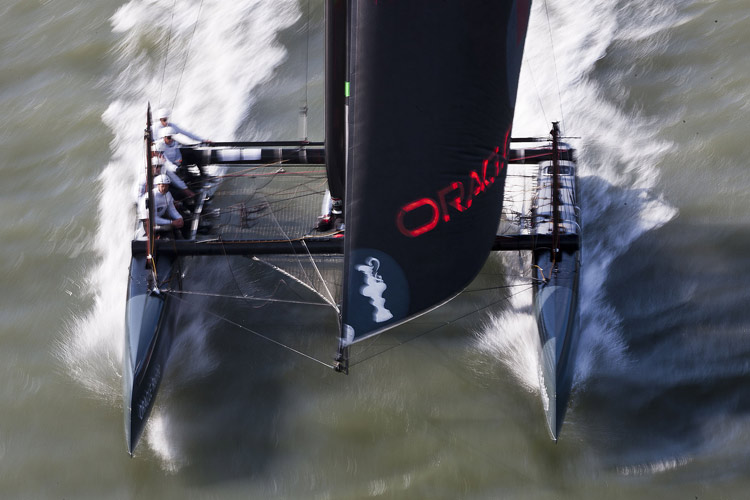
Oracle's AC45 coming at you. The team's AC72 will be coming even
faster in less than 5 months.
Photo:©2012 Guilain Grenier/Oracle Racing
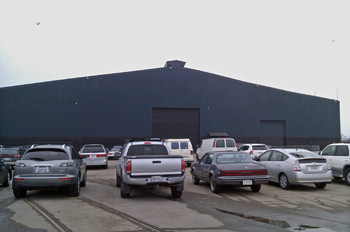 |
|
|
Pier 80 in stealth mode.
Click image to see more. |
Oracle Racing operates out of a base south of AT&T Park in San Francisco that can be described as spartan at best. Identified as Pier 80 only if you know what you’re looking for, there are few indications at first that this base is occupied by the Defender of the America’s Cup -- no billboard signage, no flags. Only a healthy array of razor wire gives the uninitiated visitor a clue that something serious is going on behind the gates.
On a foggy Tuesday, Oracle Racing hosted local media at the base for tours, a press conference, and a ride aboard the historic USS Potomac, President Franklin Delano Roosevelt’s “floating White House”.
Guests were taken first through the lair where the next generation of America’s Cup boats is being built. Behind a shed-wide curtain declaring the area “Top Secret” sit the molds in which Oracle Racing's two AC72 catamarans are taking shape, literally before visitors' eyes. Long layers of carbon-fiber were being placed into the molds by Oracle crew wearing white cotton gloves, to avoid contaminating the materials with oils from their skin. The only problem? Cameras were forbidden, though tour guide, design team coordinator Ian “Fresh” Burns, was happy to answer nearly any and all questions, along with rig designer Scott Ferguson, structural engineer Kurt Jordan, and design engineer Aaron Perry.
The press conference followed, with Oracle Racing CEO Russell Coutts, helmsman James Spithill, tactician John Kostecki, and designer Dirk Kramers sharing their views about racing for the historic trophy in San Francisco, the dangers of the AC72, and how quickly the rest of their America’s Cup competitors might get up to speed on the nuances of the 2013 Cup venue.
Four-time America’s Cup winner Russell Coutts asserts that the new Cup boats and the new venue will showcase all that is right with the America’s Cup world.
“I think the Cup here on San Francisco Bay will be just spectacular,” Coutts said. “We’ve seen the AC45, and the AC72 wings will be twice as high as those boats and will go somewhere between two and three times the wind speed.”
Coutts didn’t miss the chance to lobby the City of San Francisco, reminding them of the impact the America’s Cup made on the city and port areas of Fremantle, Auckland, and Valencia -- just in case there are still a couple of members of the SF Board of Supervisors that needed any more convincing.
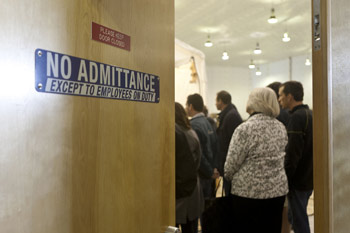 |
|
|
This means you. |
“Fremantle was a quiet, sort of rundown fishing port before the America’s Cup went there. The same thing happened in Auckland, but on an even bigger scale. I even look back on my past life as an Olympian," says Coutts. Today it's hard to imagine all that Barcelona gained as a legacy of hosting the Olympics, but, says Coutts: "It really transformed the city into one of the most popular destinations in the world. It reconnected the waterfront with the old city. So this is much more than a sailing event.
“Once you picture the spectacular boats, racing in a summer of activity in San Francisco, it’s going to be a really cool event.”
One of the easiest knocks on the Cup right now is to question the number of challenging teams -- only Sweden’s Artemis Racing, Emirates Team New Zealand, and their training partner Italy’s Luna Rossa, have already paid the entry fee due by June 1, 2012. Aside from having the millions in financing in place for their AC72's, and hence the confidence to put down the $200,000 fee early, these three are among the stronger of the eight challenger entries. The difficult international economic climate certainly looms over this edition of the Cup -- so is quality going to trump quantity?
“The situation in Europe obviously affects things. There are four teams out there building two AC72s, three other syndicates that are going to be two-boat programs,” says Coutts. “For the one-boat programs, you don’t actually have to announce that you are building a boat until June 1. There is at least one other single-boat [challenge] that will be or might have already started building a boat. So I think we will see other teams before the so-called Big Four teams. But even eight of these AC72's out on San Francisco Bay? I think that will be a pretty cool thing to see.”
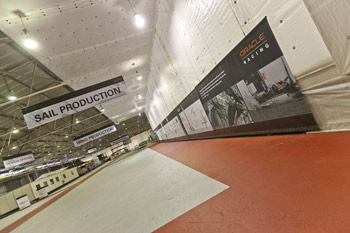 |
|
|
Production floor.
See Oracle Press Release
for more on the Team's preparations to build and launch
their new AC72's. |
Coutts also throws one very large bone to the home crowd: the image of two Oracle Racing boats hosting exhibition-style races against each other simultaneous with the Louis Vuitton Cup, the challenger selection series. With the prospect of a second Oracle AC72 helmed by British Olympian Ben Ainslie competing head-to-head with the "A" team driven by Spithill, could the undercard outdraw the challenger event? Coutts doesn’t think so.
“In terms of the four teams that currently have the two-boat programs underway, I think all of them are very competitive,” he says. “So in a competitive sense, at the end of the day, the America’s Cup is going to be about the best challenging team racing the team from the US. I think that race will be as competitive as any I’ve seen in my America’s Cup experience. I think the Louis Vuitton Cup, because of the quality of the teams, will be as competitive as the previous Louis Vuitton Cups. So yes, frankly, it would be nice to have more teams, but if we don’t, this will still be a spectacular event.”
“But there is a tentative schedule laid out, in the program of racing, where we’ll be racing our two boats at the same time as the Louis Vuitton Cup. We’re scheduled to race first on most of those days, and then the challengers will race.”
How will Ainslie fit into the Oracle picture? Coutts hints that the line-up is pretty much set.
“We have a pretty good idea of who our sailing team will be now, and we’re gearing everything towards supporting that. But in my experience, you really need to have that competitive series leading up to the America’s Cup series of matches. Because if you don’t, imagine going out and racing the best challenger cold. So one of our challenges is to develop an internal race program that prepares our team even better. It’s a tough thing to do, but we have the capability to do that.”
Helmsman James Spithill knows what lies ahead, having won back the America’s Cup for the US two years ago in Valencia, Spain. Spithill was happy to turn the clock forward to 2012, look at an America’s Cup happening next year, and stare the challenges of the somewhat daunting AC72 square in the eye.
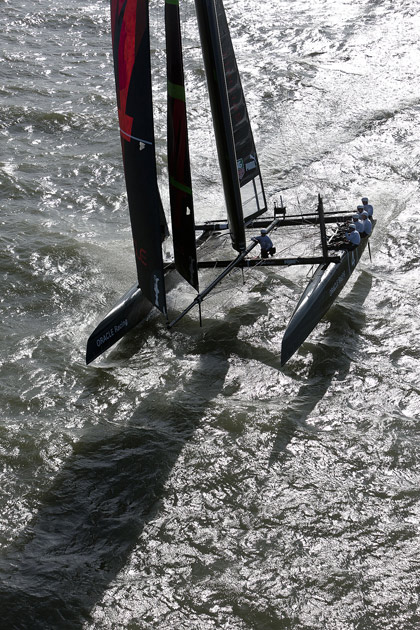 |
|
|
Oracle's AC45. The AC72 will
be twice as wide, 75% longer, with a wing nearly twice as
tall and four times the sail area.
Read More |
“We’re very, very close to the launch of our new boat, which will be in July,” said Spithill. “So for the sailing team, it’s great to be back out on the water, back out on that racetrack, getting used to what it will be like in a very short amount of time.”
Spithill looks forward to the launch of the AC72, knowing that the designers have taken into consideration much of what the sailing team has learned from the AC45.
“The sailing team is the end user, the customer. So we’ve had to have a big influence in the boat. It’s exciting for the sailing team as well as the design team, because it’s a blank sheet of paper. With the old class, we went through a few iterations, but we knew what it would be like. But now, we’ve got a few challenges -- we’ve got two hulls, a trampoline, trying to figure out the deck layout. How we’re going to get through these maneuvers and doing all this in a very short race is going to be very challenging. It’s something that goes on on a daily basis, with the design team and the build team.”
There has been a great deal of conversation lately regarding safety with the gargantuan AC72. Russell Coutts wanted a racing series that compared to NASCAR, but even a race car driver knows what happens when something goes wrong at high speed. So does Spithill.
“On the sailing side, there is a great deal more risk now. People are excited when they see Russell go through the wing, but at the end of the day, if there’s more risk, it’s more challenging for the athletes. In a race car, the harder you push, the faster you go. In the past, with the old boats, there wasn’t a real risk; maybe you would bump the boats together or tear a sail. But now, on the AC72, there are some serious consequences. But if you push, you’re rewarded for it. And I think, for the Everest of sailing, the America’s Cup, it needs to be like that. It’s not for the average person. This is right on the edge, and the team that pushes the hardest will be rewarded. And that’s exactly the way it should be.”
Structures designer Dirk Kramers, who has has seen more than his share of change in the America’s Cup, feels that the exotic boats that will contest the 2013 Cup give the venerable event a much-needed, um, aft lift vector.
“What’s happening now with the Cup is the biggest kick in the a-- that the Cup has seen in years,” says Kramers. “And you’re going to see it, front and center, right here on the Bay. That’s going to be fantastic.”
Kramers also acknowledged the work the design team is doing with the sailing team, to make sure that the final product, the AC72 that will race for the 34th America’s Cup, is optimized for the sailors’ needs.
“We’re trying to figure out how to make deck layouts work, how to power these boats. These boats will be very demanding on the crews, so we’ll have to develop systems to help these guys sail the boats.”
As for Kostecki, the kid who grew up on San Francisco Bay earning championships that started with a Sunfish title in 1982, a certain amount of local knowledge goes a long way. Or at least until everyone else gets here.
“The strong sea breeze during the summertime is pretty spectacular, with tricky currents,” said Kostecki. “San Francisco is a natural amphitheatre, so it will be awesome for what we’re doing with the America’s Cup. It’s a difficult place to race sailboats, but, when you get it right, it’s quite rewarding.
“Being a local, I’d like to think that we have an advantage, but I know we’ll see the other teams arrive here this summer, sailing the AC45's out on the same racecourse, and they’ll all get used to these conditions. It is tricky and it does take a little bit more time than a normal racetrack, but they’ll figure it out.”
-- Diane Swintal for CupInfo/©2012 CupInfo
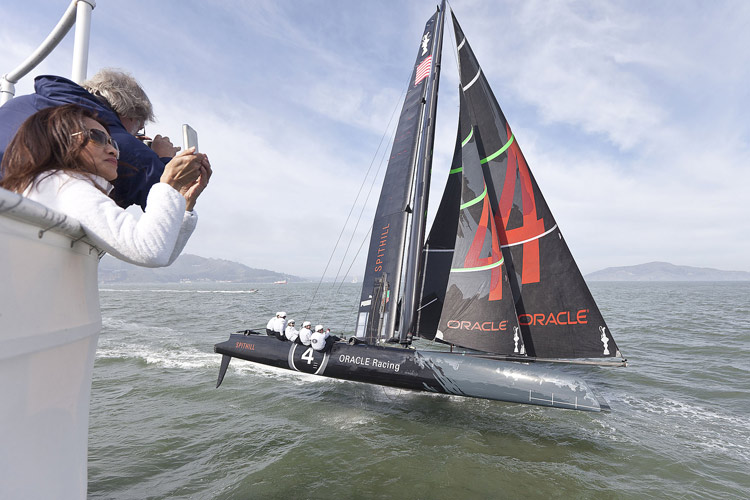
Oracle4
makes a close pass on the press boat, Tuesday. Photo:©2012 Guilain
Grenier/Oracle Racing
Links of interest: